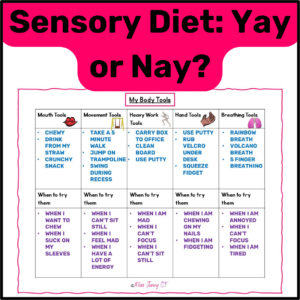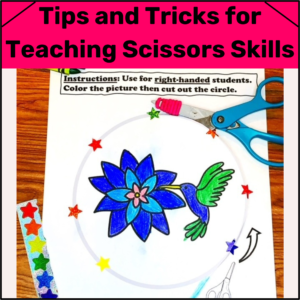Using interoception strategies to address hunger and lack of appetite can be a long and difficult process. It can also be successful with many people. I am sharing a case study of some potential strategies that may work for clients.
Case Study
***Some potentially identifying details have been changed. Not all diagnoses are included for this child to maintain confidentiality.
TS was first identified as having issues when he was admitted to the hospital at 10 months of age with failure to thrive. He was diagnosed with multiple issues over time, including mild CP (cerebral palsy), swallowing issues, and autism. His overall development was delayed in all areas. He received regular physical therapy, occupational therapy, and speech language therapy.
Hunger Status
TS did not demonstrate any hunger cues (crying, reaching for food, or asking when he became verbal). He ate very little and eventually had a feeding tube placed for supplemental feeding. Purees were his main form of intake by mouth. The speech language pathologist attempted to introduce textures to his food but he never progressed past adding crumbs to his food.
Using Interoception Strategies to Address Hunger
TS lacked awareness of most body sensations. He would play with layers of clothing on and not notice that he was overheated (red face, sweating). He would refuse to remove layers at those times. We needed to start at the beginning of the interoception process before addressing his appetite. Building awareness of his overall body sensations was essential to being more aware of his inner body sensations.
We used many different strategies to address interoception:
- started with working on awareness of how his hands felt (wet vs dry, cold vs hot, dirty vs clean)
- we started at a sink and narrated how our hands felt in the water and after drying them
- we played with toys in a tub, giving cars a car wash and giving dolls a bath
- his parents narrated how their hands felt at home
- after playing outside, his parents had him inspect his hands to determine if they were clean or dirty
- during bath time, parents repeated all of the above, and included feet and rest of body
- we had him describe how his skin felt after we described ours, then progressed to asking without first telling our sensations
- worked on awareness of other external body parts
- listened to music and noticed when the volume was too loud and hurt our ears
- looked outside when it was bright and talked about how the light hurt our eyes
- smelled different things to see if we liked them or not
- began addressing hunger
- parents narrated how their bodies felt when hungry (empty tummy, shaky muscles)
- after eating parents narrated how their tummies felt hard and full
- practiced pushing our bellies out to simulate feeling full
- laid on yoga ball to feel pressure on our bellies
- pointed out when someone’s tummy “growled” or his did
- used balloon full of air to show full belly and let air out to simulate empty belly
- watched child-friendly videos about feeling hungry
- discussed how his belly felt before and after every feeding by mouth and tube feeding
- parents pointed out when his belly looked firm after eating
Results
TS began to slowly improve in his ability to notice his body signals. He began to notice when his body was warm or cold and needing to change his clothing to address the temperature. Prior to eating (at scheduled times), he would put his hand on his belly to feel it, then feel it again after eating. One day, before a scheduled feeding, he told his mom, “I am hungry”! TS also began reporting feeling full. He was able to cut back on the tube feedings but not completely stop. He continued supplemental feeds due to his physical issues and inability to eat sufficient amounts for his health.
By last report, TS was eating 3 meals per day (plus snacks), requesting to eat when hungry, and telling an adult when he was full. This process took a few years and will continue for him as he grows.
Using interoception strategies to address hunger can be one way to improve appetite. It does not work for everyone. It can be a long and complicated process. Working with professionals such as speech and language therapists, feeding specialists (may be an SLP, an OT, or other), and dieticians is often essential. Medical issues need to be ruled in or out as the cause of hunger issues. Potential issues with swallowing, as well as any sensory issues need to be addressed. All of these were done in addition to the above strategies with TS.
How have you addressed hunger and/or lack of appetite with people in your life?








